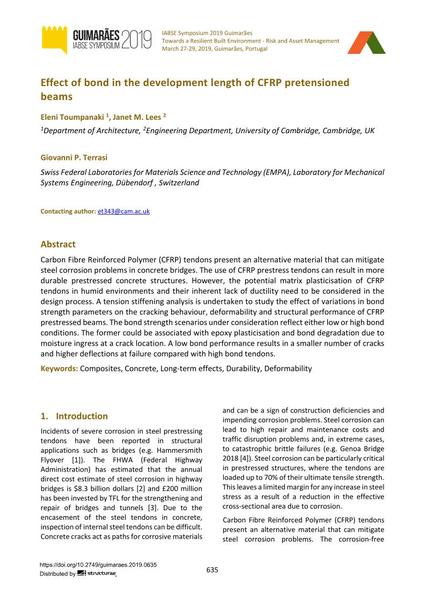Effect of bond in the development length of CFRP pretensioned beams

|
|
|||||||||||
Bibliographic Details
| Author(s): |
Eleni Toumpanaki
(Department of Architecture, 2Engineering Department, University of Cambridge, Cambridge, UK)
Janet M. Lees (Department of Architecture, 2Engineering Department, University of Cambridge, Cambridge, UK) Giovanni P. Terrasi (Swiss Federal Laboratories for Materials Science and Technology (EMPA), Laboratory for Mechanical Systems Engineering, Dübendorf , Switzerland) |
||||
|---|---|---|---|---|---|
| Medium: | conference paper | ||||
| Language(s): | English | ||||
| Conference: | IABSE Symposium: Towards a Resilient Built Environment Risk and Asset Management, Guimarães, Portugal, 27-29 March 2019 | ||||
| Published in: | IABSE Symposium Guimarães 2019 | ||||
|
|||||
| Page(s): | 635-642 | ||||
| Total no. of pages: | 8 | ||||
| DOI: | 10.2749/guimaraes.2019.0635 | ||||
| Abstract: |
Carbon Fibre Reinforced Polymer (CFRP) tendons present an alternative material that can mitigate steel corrosion problems in concrete bridges. The use of CFRP prestress tendons can result in more durable prestressed concrete structures. However, the potential matrix plasticisation of CFRP tendons in humid environments and their inherent lack of ductility need to be considered in the design process. A tension stiffening analysis is undertaken to study the effect of variations in bond strength parameters on the cracking behaviour, deformability and structural performance of CFRP prestressed beams. The bond strength scenarios under consideration reflect either low or high bond conditions. The former could be associated with epoxy plasticisation and bond degradation due to moisture ingress at a crack location. A low bond performance results in a smaller number of cracks and higher deflections at failure compared with high bond tendons. |
||||
| Keywords: |
concrete durability composites long-term effects deformability
|
||||
